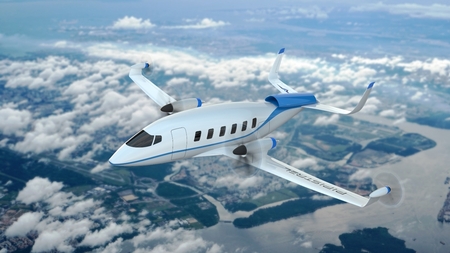Published February 11, 2021 12:00

Pipistrel makes significant progress with Miniliner designs for a new generation of zero-emission aerial mobility
Pipistrel is proud to announce that conceptual design studies that have been conducted are indicating significant market potential on the premise of identified technological and infrastructural feasibility. Our Miniliner concept will deliver a leading solution for future small regional aircraft that will enable clean, fast, and cost-effective transportation.
The Miniliner is a new kind of zero-emission airplane in the 20-seat size class, capable of operating quietly from runways shorter than 1 km, including grass airstrips at small aerodromes. These aeroplanes have therefore the potential to disrupt aerial mobility, connecting currently unserved populations at 200 to 1,000 km range, but also catering for microfeeder services from small airports to large hubs.
Having started considering larger zero-emission aircraft already as a part of the MAHEPA project several years ago, Pipistrel is now actively performing conceptual design studies in-house, as well as partnering with universities under the also EU-funded UNIFIER19 project.
While several powertrain solutions are being evaluated, advanced hydrogen-based propulsion systems answer the non-negotiable requirements of zero-emission, quiet and safe operations.
Current aircraft in this segment rely on 40-year-old designs, powered by fuel-burning, noisy and maintenance-intensive turboprop engines. Pipistrel’s Miniliners allow for a Direct Operating Cost (DOC) reduction of 30 to 40% on a per-seat metric relative to today’s solutions, even with the introduction of new zero-emission propulsion, real-time emissions monitoring and advanced flight control automation technologies. The latter will, at the same time, facilitate single-pilot operations.
Pipistrel aims for an EIS (Entry into Service) of 2028-2030, as the proposed concepts are geared towards not requiring large infrastructural investments. To overcome current challenges on the regulatory, operational, and technological domains, Pipistrel is engaging with Europe’s Clean Aviation, SESAR, and EASA, as well as setting up multiple industry partnering initiatives.
We are excited to be surrounded by like-minded organisations which will achieve regulatory adaptations to next-generation single-pilot cockpits and commuter operations from unpaved runways. Microfeeder flights will leverage advanced air traffic control systems to safely integrate the miniliners into the busy airspaces around large airports. With airports becoming zero-emission multimodal nodes, as directed by EC Sustainable and Smart Mobility Strategy, hydrogen powered zero-emission miniliners are every day closer to reality and will Springboard the developments to bring Clean Aviation closer to communities.